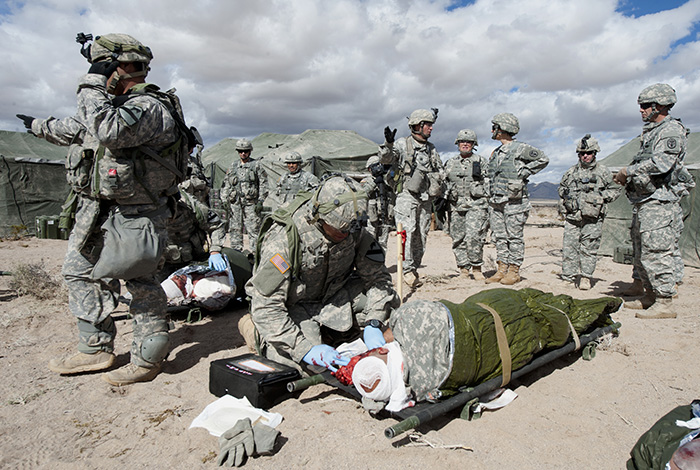Training, Technological Synergy Likely the Key to Future Battlefield Care Scenarios

The first slide on the screen during Maj. Doug Powell's panel presentation on prolonged field care at the 2017 Military Health System Research Symposium in Kissimmee, Florida, features a blank, colorless slate without any pictures, graphics or images. Instead, there's just a single quote.
"It's not about the technology," the slide reads, "It's about the people."
For Powell and the rest of the investigators diving head first into the Army's newly-retooled commitment to prolonged field care–the number one capability gap according to a recent Army Capabilities Needs Analysis–the quote doubles as both a mantra and a mission statement.
"We carry around one of the greatest and most powerful computers of all time in our pockets every day," said Powell, holding up his cell phone to the audience, "and we use it to play 'Candy Crush.'"
He added, "We can do better."
Given that desire for a more complete, more mature fusion of technology and Warfighter, Powell's presentation focused chiefly on the burgeoning telemedicine requirements for prolonged field care in future battlefield scenarios. Products that are flexible, scalable, reliable and convenient are specifically targeted for deployment in the dense, urban settings that experts say will likely dominate combat environments in the coming years.
The presentation highlighted advanced development efforts such as an Air Force Pararescue-Jumper project called BATDOK (Battlefield Airmen Trauma Distributed Observation Kit), which is a cell phone application intended for use on Android platforms. Wireless sensors placed on the patient send aggregated vitals to the computer screen, providing PJs the ability to make emergency medical decisions. Like a cell phone, the device can be set for three kinds of alerts: Auditory, tactical or visual. The alerts notify the PJ not only to which patient is in danger, but also his or her vitals.
Situational awareness for receiving field hospitals is also important to provide medical staff on the ground with information that can help them prepare to receive and immediately treat patients. This need is being addressed by an advanced development effort at the U.S. Army Medical Research and Materiel Command called the Medical Hands-free Ultra-wideband Broadcast system. The MEDHUB's distinction is its patient care focus and operational situational awareness capability. The goal is to keep the medic or flight paramedic focused for performing life-saving tasks for multiple patients, unencumbered from documentation. The MEDHUB is designed to automatically capture, store and forward data to the receiving field hospital -- without adding any burden to the medic. Key components are individual wearable vital sign monitors that record vitals and provide littered or ambulatory status through accelerometers; peripherals to capture patient weight; and an end-user device, such as a tablet or phone, that captures and stores the data.
"Prolonged field care is not a skillset. It's a situation you find yourself in," said Lt. Col. Andre Cap, Chief of Blood Research at the U.S. Army Institute of Surgical Research in San Antonio, Texas.
For Cap, the synergy of man and machine in future far-forward environments isn't complete without first addressing the existing training gaps in the prolonged field care discipline. To that end, concepts such as a dedicated emphasis on critical care techniques and prolonged resuscitation efforts are incorporated into current medical training regimens. Additionally, leadership has instituted a pilot program focused around those concepts at Fort Bragg, North Carolina.
"We are still fighting the new war with the tools from the old war," said Cap, "and that has to change."
Both Cap and Powell say that moving forward current capabilities gaps in prolonged field care will include a dedication to the concept of universal interoperability among technological devices, as well as the development of an on-demand, on-call marketplace for continuous communication regardless of location.
Still, the immediate focus remains on strengthening current training, development and execution processes, all while paying special attention to the integration needed to succeed on the future battlefield.
Said Powell, "Whatever we eventually give to the people in the field, I want to make sure it works with what they already have."
The MHSRS is the DOD's premier scientific annual meeting, which combines three previous conferences, including the former Advanced Technology Applications for Combat Casualty Care Conference; the Air Force Medical Service Medical Research Symposium; and the Navy Medicine Research Conference. By combining these conferences into one event, the meeting serves as a critical strategy session for leaders to set future milestones for the Department of Defense's deployment-related medical research programs, centered on the needs of the Warfighter.














